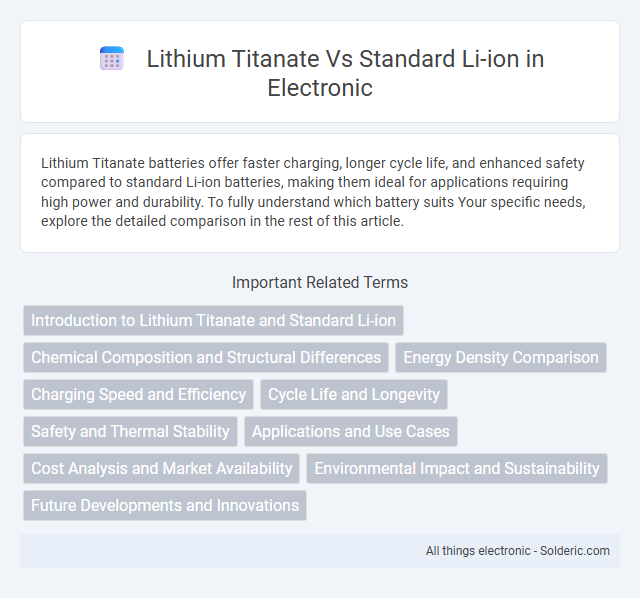Lithium Titanate batteries offer faster charging, longer cycle life, and enhanced safety compared to standard Li-ion batteries, making them ideal for applications requiring high power and durability. To fully understand which battery suits Your specific needs, explore the detailed comparison in the rest of this article.
Comparison Table
| Feature | Lithium Titanate (LTO) | Standard Lithium-ion (Li-ion) |
|---|---|---|
| Charge Speed | Very fast (minutes) | Moderate (hours) |
| Cycle Life | Up to 20,000+ cycles | 500-1,000 cycles |
| Energy Density | 60-80 Wh/kg | 150-250 Wh/kg |
| Safety | Highly safe, stable chemistry | Moderate risk of thermal runaway |
| Operating Temperature | -30degC to 55degC | 0degC to 45degC |
| Cost | Higher upfront cost | Lower upfront cost |
| Applications | Fast charging, EVs, grid storage | Consumer electronics, EVs |
Introduction to Lithium Titanate and Standard Li-ion
Lithium Titanate (LTO) batteries use lithium titanate oxide on the anode, offering faster charge times, longer cycle life, and enhanced safety compared to standard lithium-ion batteries, which rely on graphite anodes. Standard Li-ion batteries provide higher energy density, making them suitable for applications requiring longer runtimes but with slower charging and shorter lifespan. Understanding the differences can help you choose the right battery technology based on performance, durability, and safety needs.
Chemical Composition and Structural Differences
Lithium Titanate (Li4Ti5O12) anodes feature a spinel crystal structure, providing exceptional structural stability and fast lithium-ion diffusion compared to the layered oxide structure of standard lithium-ion batteries, typically using graphite anodes. The unique chemical composition of lithium titanate enables near-zero strain during charge-discharge cycles, significantly enhancing cycle life and safety. In contrast, standard Li-ion batteries rely on intercalation in graphite anodes, which undergoes greater volume expansion, impacting battery longevity and thermal stability.
Energy Density Comparison
Lithium Titanate (LTO) batteries have a lower energy density, typically around 70-90 Wh/kg, compared to standard lithium-ion batteries, which usually range from 150-250 Wh/kg. This significant difference means standard Li-ion batteries can store more energy per unit weight, making them preferable for applications requiring lightweight and high-capacity storage. However, LTO batteries compensate with faster charging rates and longer cycle life, despite their lower energy density.
Charging Speed and Efficiency
Lithium Titanate batteries offer significantly faster charging speeds compared to standard Li-ion cells, often reaching a full charge in under 10 minutes due to their unique nanostructured anode. This rapid charging capability also enhances cycle life and efficiency, with Lithium Titanate maintaining higher performance after thousands of charge cycles. Your choice between these batteries depends on whether ultra-fast charging and longevity outweigh the higher cost and lower energy density of Lithium Titanate compared to conventional Li-ion technology.
Cycle Life and Longevity
Lithium Titanate (LTO) batteries boast an impressive cycle life of up to 20,000 cycles, significantly outlasting Standard Li-ion batteries, which typically offer around 500 to 1,000 cycles. This extended longevity makes LTO ideal for applications demanding frequent charge-discharge cycles and high durability. Your choice between these technologies impacts overall replacement costs and system reliability due to their differing lifespans.
Safety and Thermal Stability
Lithium Titanate batteries offer superior safety and thermal stability compared to standard Li-ion batteries due to their enhanced chemical structure, which reduces the risk of overheating and thermal runaway. Their stable anode material allows for rapid charge and discharge cycles without significant degradation or temperature spikes, making them ideal for applications requiring high safety standards. Your choice of Lithium Titanate cells ensures safer energy storage, especially in high-demand or temperature-sensitive environments.
Applications and Use Cases
Lithium Titanate batteries excel in applications requiring rapid charging and high cycle life, such as electric buses, military vehicles, and grid energy storage systems due to their superior thermal stability and durability. Standard Li-ion batteries dominate consumer electronics, electric cars, and portable devices because of their higher energy density and lower cost. The choice between Lithium Titanate and standard Li-ion depends on specific use cases prioritizing either longevity and safety or energy capacity and affordability.
Cost Analysis and Market Availability
Lithium Titanate (LTO) batteries generally have higher upfront costs than standard Li-ion batteries due to more complex manufacturing processes and the use of titanium oxide anodes, which are less common and more expensive. Standard Li-ion batteries benefit from large-scale production and widespread adoption, making them significantly more cost-effective and readily available in global markets. Market availability of LTO remains limited primarily to specialized applications such as fast-charging electric vehicles and grid storage, while standard Li-ion batteries dominate consumer electronics and automotive sectors.
Environmental Impact and Sustainability
Lithium Titanate (LTO) batteries exhibit enhanced sustainability due to their longer cycle life, resulting in reduced resource consumption and waste generation compared to standard lithium-ion batteries. LTO chemistry uses less cobalt and nickel, metals associated with significant environmental and ethical concerns in mining. Lower thermal management requirements of LTO cells diminish energy consumption during operation, further minimizing their environmental footprint relative to traditional Li-ion technologies.
Future Developments and Innovations
Lithium Titanate (LTO) batteries offer faster charging and longer cycle life compared to standard Lithium-ion (Li-ion) batteries, driving innovation in electric vehicles and grid storage applications. Future developments focus on improving LTO energy density and reducing costs to compete more effectively with high-capacity Li-ion chemistries like NMC and LFP. Advances in solid-state electrolytes and nanomaterial coatings are expected to enhance LTO battery safety, lifespan, and performance for broader adoption.
Lithium Titanate vs Standard Li-ion Infographic

 solderic.com
solderic.com